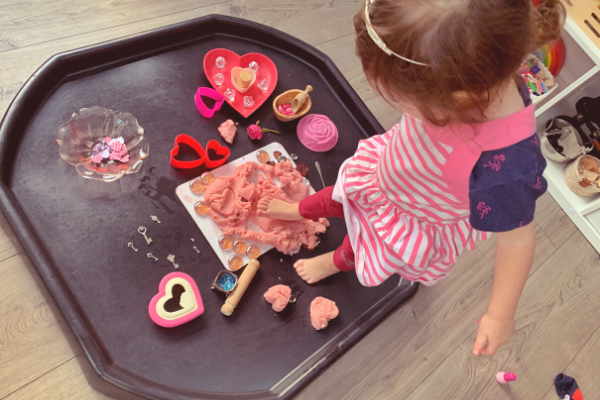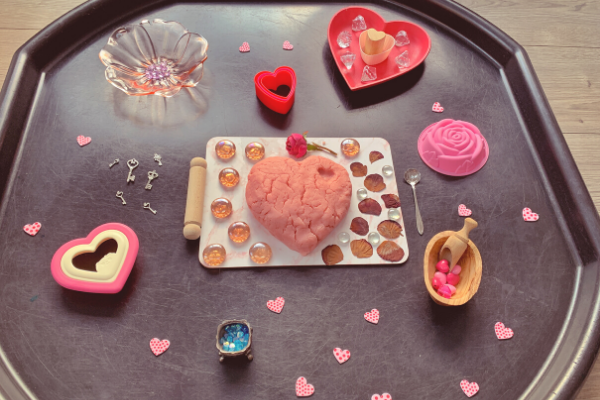Valentine's Day Tuff Tray | Sensory Play
2 Cups of Salt
8 Tsp of Cream of Tartar
4 Cups of Water
2 tblsp Oil
Optional extras:
Pink food colouring
Rose essential oil
(links to products below)
Resources for the Valentine's Day tuff tray:
Hot pink food colour - https://amzn.to/42E9G8t
Cream of tartar - https://amzn.to/3SGlQJe
Organic Sunflower oil - https://amzn.to/3uBheMs
Refined salt - https://amzn.to/3UCbtJ8
Plain flour - https://amzn.to/4bIWgMC
Rose Essential oil - https://amzn.to/3SLjIzM
Pink Marble placemats - https://amzn.to/3ONyxRg
Wooden heart tray plate: https://amzn.to/3OLlDDy
Silicone flower cake moulds - https://amzn.to/3T1c7i4
Nesting heart cutters - https://amzn.to/48lUPAK
Star cutter - https://amzn.to/3wllMqU
Heart shaped sandwich sealer - https://amzn.to/49i2l0K
Pink gems - https://amzn.to/3OJr1a0
Quartz pink lustre gems - https://amzn.to/42F2poN
Heart stickers - https://amzn.to/49cWpWK
Acacia scoop - https://amzn.to/3I2BNod
Olive wood bowl - https://amzn.to/3I4sxQk
Silver mini keys - https://amzn.to/3UG85gg
Acrylic hearts - https://amzn.to/3wm9XAP
Pink acrylic hearts - https://amzn.to/49ihe2W
Silver flower spoons - https://amzn.to/3wiG5W3
Artificial rose - https://amzn.to/3wrILQV
Dried rose petals and rodebuds - https://amzn.to/3SJKpVx
Children’s wooden rolling pin - https://amzn.to/3uI75xu
Tuff tray - https://amzn.to/3I0uKw6
Hopefully the image links above have helped you to source the resources you need and you are ready to get started!
Now, if you want some good examples of how to GIVE LANGUAGE to babies and toddlers, during play, and some pointers of things you should try and avoid saying, pop over and have a read of my post all about developing speech and language in babies and children here and also this post all about developing language through sensory play.
- Touch - feeling the playdough and the different resources, their temperature and how hard or soft they are.
- Smell - especially whilst making the playdough, but also afterwards with the addition of the rose petals and the essential oils.
- Sound - Listen for the noises whilst pouring the ingredients. Do the resources make any sounds when you interact with them?
- Taste - this is mainly for whilst cooking the playdough, I wouldn't encourage eating it as it is very salty, although it is taste safe.
- Sight - Using objects of varying transparency and brightness offers opportunities for language. As does the use of shapes and recognisable objects.
Here are some examples of describing words that could be used on some of the sensory resources above, depending on age and stage of development:
- soft / hard
- rough / smooth
- sticky
- fuzzy
- squishy
- shiny
- sparkly
- cold / warm
- round / circle / sphere/ heart/ love heart
- see through / transparent
- opaque
- 2d / 3d /flat / solid
- small / little / short / smaller / shorter
- medium sized
- big / large / wide / tall / bigger / larger / wider / taller
- heavy / light
Here are some example of verbs that could be used on the sensory resources above:
- rolling
- squashing
- pushing
- squeezing
- pinching
- peeling (stickers)
- poking
- lifting
- holding
- patting
- pressing
- scooping
- pouring
 |
| Scooping |
 |
| Rolling |
 |
| Pushing and Pressing |
 |
| Squashing |
Extending the tuff tray activity beyond child-led
Scaffolding and supporting an extension activity:
You can still offer scaffolding or support when working with children in a child-led way. After Charlotte had attempted her own version independently, I wanted to show her how she could be more successful in her attempt at a love heart shape by giving her a guideline to work to. I gently pressed a heart cutter into her dough in order to make an outline and placed two beads on top of the line to demonstrate how this can be done. I then left her to try for herself....
















